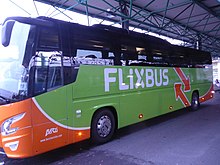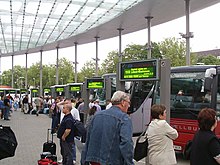The long-distance bus service in Germany is next to that Long-distance rail traffic one of the ways to make long-distance travel by public transport. Even if the travel times are usually longer than by train, the long-distance bus, like the long-distance train, is a very environmentally friendly means of transport, especially compared to the To fly as well as driving with Car or motorcycle. Long-distance bus journeys within Germany have also been possible since 2013; before 2013 long-distance bus journeys were only abroad or to Berlin possible and were predominantly made by long-distance bus associations such as Eurolines carried out.
background




Until the end of 2012, the approval of long-distance bus lines within Germany to protect the existing railway lines was not permitted under the German Passenger Transport Act (PBefG). Since 1935, long-distance bus traffic was only possible on routes in which this transport service was not sufficiently provided by other means of transport. In practice, this meant that the existing long-distance bus routes within Germany were mainly airport feeders and connections to Berlin. In addition, there were also a few stops within Germany for long-distance buses to neighboring countries.
At the beginning of the new millennium, for various political reasons, a rethink began and the PBefG was gradually reformed: Since August 2011, long-distance bus routes with stops of at least 50 kilometers have been allowed. This limit was also lifted in January 2013.
Since then, a market for long-distance connections between cities in Germany has developed increasingly. The long-distance bus companies themselves do not have their own buses. These are provided by regional entrepreneurs as wage companies under the uniform logo. In the event of the bankruptcy of a large operator, there is therefore no scope for possible recourse. Several providers have already given up: First of all City2City, a subsidiary of the British National Express, later also the rail subsidiary “BerlinLinienBus” and the Post subsidiary “Postbus”. As a result of these market exits and mergers, the market is now dominated to a considerable extent by Flixbus and there is hardly any choice between different providers on many lines.
Tickets
Most tickets are purchased as online tickets either via the homepage of the respective long-distance bus company or via apps offered by most long-distance bus companies. It is also possible to purchase tickets in the customer centers of the long-distance bus companies or by telephone using the service numbers. Tickets for the IC bus, which belongs to Deutsche Bahn, can also be purchased at ticket machines and in the travel centers of train stations. Many long-distance bus companies also cooperate with travel agencies when selling tickets. If there are still vacancies on the bus, tickets can also be purchased from the bus drivers shortly before departure. However, these are usually more expensive than tickets from the advance sales of the other sales channels.
Prices
In general, the prices of long-distance bus connections are often under those of a regular train connection in order to be competitive with the already existing and usually faster train connections.
All bus companies calculate individual prices for each route, the prices vary accordingly depending on the occupancy of the journey. The most expensive are cards bought directly from the driver at the standard rate. Tickets from advance sales on the Internet, in travel agencies, from contractual partners and in the customer centers of the bus companies are cheaper. There are currently no customer loyalty offers such as discount cards similar to the Bahncard in Germany. However, tickets with a BahnCard discount are also valid and available on the IC bus. Since long-distance buses, unlike city and regional buses, are run independently and do not receive any financial benefits from tax revenues, they have to be financed entirely by the fare income. Therefore, the prices of long-distance bus tickets are adjusted to the current supply and demand. However, this applies not only to long-distance buses, but also to special offers from long-distance rail transport and airlines for short-haul flights. In contrast to trains, however, buses do not pay any train path fees.
The market consolidation has now largely been completed and apart from Flixbus there is only the train on many routes. Logically, the days of ultra-cheap tickets are over. Since the railways are now using a more aggressive pricing strategy, it is not uncommon for a train ticket - especially with a Bahn Card - to be cheaper than the bus. However, it is also worth comparing here, as travel times should also be taken into account and cheaper maps are often only available for indirect routes.
On routes where there is still more than one provider, however, tickets can still be purchased at low prices. One example is Dresden-Berlin, where three providers (Flixbus, Eurolines, RegioJet) are still active.
Furnishing
buses

The operators and their long-distance buses are mostly quite new. They are therefore usually comfortable coaches with WLAN connections and 230V sockets under the seats as well as reading lamps and adjustable ventilation. Snacks and cold drinks are mostly available from the drivers. Some buses also have hot drinks machines. There are storage areas for hand luggage above the seats. Some long-distance bus companies display passenger magazines on the buses. Toilets are also found in all long-distance buses. There are closable curtains on the windows.
Travel and long-distance buses are classified according to a system designed by the operator industry (in the form of the gbk - Gütegemeinschaft Bus Komfort e.V.), which ranges from one to five stars (RAL quality mark for bus comfort). Depending on the length of the journey, different criteria such as seat spacing, basic equipment and seating equipment, night lighting, luggage rack (storage space) are defined.
Stops

With the liberalization of the national long-distance bus market in 2013, different systems were used in German cities and towns to enable long-distance bus passengers to stop and hop on and off and change trains. In 1 Hamburg for example, there is an official one Long-distance bus station, which was previously a bus station for city and regional buses as well as long-distance buses for international lines such as Eurolines and was adapted to the new requirements of additional long-distance bus stops and other, sometimes new, long-distance bus companies through refurbishment and renovation. In long-distance bus stations there are often sanitary facilities and public showers, customer centers with ticket sales for many long-distance bus companies such as Flixbus, Eurolines or Regiojet, as well as fast-food restaurants, drugstores and supermarkets, kiosks and ATMs. Retail shops are exempt from the Act on Closing Times in long-distance bus stations. In some long-distance bus stations, there are also heated waiting rooms or covered and sheltered outdoor waiting areas. Completed long-distance bus stations are located in Hamburg, 2 Central bus station in Munich, 3 Frankfurt am Main, 4 Berlin (2016-2019[outdated] Conversion and expansion during ongoing operations) and other cities, in some other cities long-distance bus stations are under construction.
Travel times
Since the long-distance buses run on the usual motorways and roads, delays occur for the long-distance buses, especially in the partial stages of the city crossings during the peak traffic times that are prone to congestion. The travel times are therefore almost always higher than those of a comparable train connection. It is a legal requirement that drivers take a break of at least 30 minutes after no more than four and a half hours. This can mean that what was originally a slight delay becomes a very long delay, as the driver has to take a break that is not provided for in the timetable, but many long-distance buses are generally occupied by two bus drivers, and stopping at the stops is also a driving break.
If you want to arrive quickly, you shouldn't leave on Friday. Long-distance bus journeys at night as well as from Monday to Thursday and on Saturdays are particularly time-saving. Sunday is particularly recommended for long-distance bus travelers, as trucks are then not allowed to drive.
Long-distance bus operator

This list shows the largest long-distance bus companies in Germany, and some foreign long-distance bus companies also operate trips in Germany. Pure airport feeders and private shuttle services are not included in this list.
- BlaBlaBus. Tel.: 420 (0) 539 000 322. BlaBlaBus is a French long-distance bus operator that also offers journeys within Germany. At least until spring 2021 is operations ceased.
- euroLines (German touring), Am Römerhof 17, 60486 Frankfurt am Main. Tel.: 49(0)6196 2078-501, Email: [email protected]. Eurolines is a Europe-wide association of long-distance bus operators, the German representative is Deutsche Touring. Cities all over Europe are approached.twitter url usedyoutube url used
- Flixbus (FlixMobility GmbH), Theresienstrasse 18, 80333 Munich. Tel.: 49(0)30 300 137 300. Flixbus was founded in 2011 and is based in Munich. Bus routes are used between major German cities and as far as the major cities of the neighboring countries of Switzerland and the Czech Republic. In 2015, Flixbus merged with competitor MFB MeinFernbus. The brand name was retained, but the green color palette was adopted by MeinFernbus.twitter url usedyoutube url used
- RegioJet. Tel.: 420 (0) 539 000 322.RegioJet is a Czech long-distance bus company, which operated under the former name StudentAgency. The long-distance buses can also be used for journeys within Germany. RegioJet is a long-distance bus company and private long-distance rail transport company.
- Sindbad, Ul. Działkowa 4, PL-45144 Opole. Tel.: 48 (0)801 22 33 44, Email: [email protected].
- Roadjet. Tel.: 49 7146 5380881, Email: [email protected].
Practical advice
See also:Travel themes
- If you do not get a satisfactory answer to your complaint, you can contact the Arbitration board for public transport turn. Complaints are examined and mediation proposals for amicable and out-of-court settlement of disputes are developed. That saves time and money for the industry and hardly any annoyance for the customer.
- It is recommended by the long-distance bus company to attach a luggage tag to suitcases or travel bags, on which the name and address of the traveler and the destination are noted. This makes it easier for drivers to load and unload luggage in the loading area and provides travelers with security against confusion of luggage when they are received at the exit. The luggage tags are provided by the long-distance bus company when purchasing tickets. When purchasing an online ticket, the luggage tag is delivered parallel to the receipt of the ticket as a PDF version for self-printing.
See also
Web links
- The online portal recommended by the Verkehrsclub Deutschland VCD Busliniensuche.de has a neutral timetable information and route overview of all long-distance bus companies, establishment of car pools and carpooling as well as savings prices for long-distance rail connections.
- There is an overview of all long-distance buses in Germany in the style of a timetable Simplex mobility.


